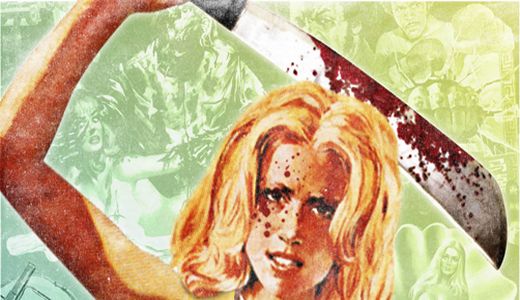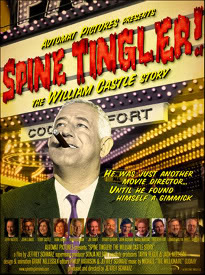There a number of documentaries screening at this year’s MIFF that look at the filmmaking process. Here are two such films, each dealing with the exploitation end of the business, focusing on markedly different eras – to say nothing of countries – but with overlapping themes and participants.
In Machete Maidens Unleashed!, Not Quite Hollywood director Mark Hartley explores another side of the exploitation cinema wave of the 1970s and 80s. Instead of Ozploitation, Hartley turns his attention to Fillipinosploitation, more specifically the countless sex-n’-violence epics produced in the Marcos-era Phillippines, often under the aegis of Roger Corman’s New World Pictures or Samuel Z. Arkoff’s American International. Home to a not-inconsiderable local film industry (though prior to the late sixites, virtually none of its films were seen abroad), the favourable exchange rate, experienced (and cheap) crews and exotic locations made the Phillippines a popular place for American producers to churn out their B-grade (and below) opuses. It also gave rise to some uniquely demented home-grown product, such as the Bionic Boy films (kid martial artist vs firebreathing robot-dragon-thingy), and midget Bond rip-off, For Ur’ Height Only. If there’s one thing to be said about all of these productions, the folks involved never let things like story, production values, or occupational health and safety get in the way of turning a quick buck…
Machete Maidens Unleashed! is assembled in the same jolly style as Not Quite Hollywood, with colourful graphics, rapid-fire edits and often hilarious clips and interviews. Among the interviewees are Corman, Joe Dante, Allan Arkush, Jack Hill, John Landis (whose caustic remarks are a highlight), along with exploitation actors Sid Haig, Margaret Markov, Chris Mitchum, Darby Hinton and more. The local side is less well-represented, with the only contributing Fillipino director being Eddie Romero (of the Blood Island trilogy, and such classics as Black Mama, White Mama and Beyond Atlantis), while the late Cirio H. Santiago (he of TNT Jackson, among others) is represented by archive interviews. The most colourful of the directors profiled, Bobby A Suarez (of They Call Her Cleopatra Wong and the Bionic Boy films) is the one whose prescence is most missed here. A flamboyant (if not particularly talented) filmmaker who always got around on set with a loaded handgun in his belt, Suarez passed away just days before Hartley got to interview him.
Though never less than fascinating and entertaining, Machete Maidens Unleashed! suffers from a lack of focus. Possibly due to a lack of available interviewees from the Fillipino industry, the film feels unbalanced, with most of the anecdotes coming from the American participants. There are some insights into how the industry operated under the yoke of Ferdinand Marcos’ reigime, but the imbalance of American comments pulls the film into occasionally irrellevant areas, such as the long digression into the production of Apocalypse Now. Unlike the pristine archive clips used in Not Quite Hollywood, the film excerpts featured here are of mostly poor quality, a combination of shoddy-to-non-existent Fillipino film archiving (in a tropical climate, no less) and a lack of remastered material from the Corman archives. Despite these problems, Machete Maidens Unleashed sheds a welcome light on a neglected corner of the film industry.
American producer/director William Castle is fondly regarded by many baby-boomer filmmakers as the king of the movie gimmick. The man behind such chillers as House on Haunted Hill, Homicidal!, and Mr Sardonicus, Castle was a master at drumming up hype for his low-budget horror epics, to very profitable results. Some of his gimmicks included Emergo (a plastic skeleton winched across the ceiling of the cinema during House on Haunted Hill), Percepto (joy buzzers installed in seats that were set off during The Tingler) and Illusion-O (a dinky “ghost viewer” to enable audience members to see – or not see – the titular spooks of 13 Ghosts), and all succeeded in packing em’ in, especially kids.
As revealed in Spine Tingler! The William Castle Story, this genial schlockmeister was a man driven by a desperate need to have an audience, bourne out of the loss of both of his parents as a child. Outwardly a smooth talker and raconteur, Castle was prone to deep insecurity, and a constant fear of losing his audience. As the optimism of the early sixties gave way to the Vietnam War, generational schisms and social unrest, Castle’s own brand of funhouse horror was overwhelmed by the harsher, more graphic likes of Night of the Living Dead, and ironically, Rosemary’s Baby, which Castle himself produced.
Despite Castle’s internal demons, Spine Tingler! is ultimately an affectionate portrait, though one that avoids hagiography. Castle’s daughter Terry shares her recollections of life with her father, while a number of collaborators (Jeannot Swarc, Diane Baker, Marcel Marceau) give their thoughts. There are plenty of comments from critics and fans (Leonard Maltin, Paul Sammon and Donald F. Glut, to name just three), while filmmakers Stuart Gordon, John Landis, Joe Dante and an especially affectionate John Waters discuss how Castle influenced their work. And yes, Roger Corman also gets in a word or two.
Even if you’ve never seen any of Castle’s films (and very few of them are available on DVD in Australia at present), you’ll still find plenty to enjoy here. This is a very satisfying examination of a man who loved to entertain, but did so out of the lingering scars of childhood tragedy.







No Responses